Bulletin – June 2014 Global Economy Infrastructure Investment in China
- Download the article 773KB
Abstract
Infrastructure investment in China has increased significantly in recent decades and has been a significant driver of economic growth and improved standards of living. Nonetheless, the level of infrastructure in China remains below that in developed countries, suggesting that the growth of infrastructure investment is likely to remain strong for some time. This outlook has implications for Australian commodity exports, as infrastructure investment is intensive in its use of steel, which in turn relies on iron ore and coking coal as inputs. While infrastructure investment in China is not without its risks, these may be mitigated to some extent by reforms proposed by the authorities, such as increasing the private sector's participation in the allocation, execution and financing of this investment.
Introduction
Investment has been a significant driver of economic growth in China over the past two decades (Graph 1). Chinese gross fixed capital formation, the measure of investment reported in the national accounts, grew at an average annual rate of 11 per cent in real terms since 2000, although this has declined to 8 per cent per annum over the past two years. This rapid growth has enabled investment in China to remain a large share of GDP, accounting for almost half of GDP in 2013 (by comparison, investment accounts for a little more than a quarter of GDP in a developed economy such as Australia and just over a third in a developing economy like Indonesia).
A significant proportion of investment in China since the early 1990s has been directed towards increasing the amount and improving the quality of infrastructure. Much of this has been driven by urbanisation in China, as cities require substantial infrastructure development to support a growing population.
The rapid development of infrastructure in China over the past few decades is reflected in the improvement in a range of social and economic indicators. However, these indicators also suggest that China still has some way to go to converge with the levels of development and standards of living in developed economies. For example, urban rail transit infrastructure is relatively underdeveloped in many large Chinese cities compared with that in large international cities in most developed economies. More generally, the Chinese authorities plan to facilitate more urbanisation in coming years (although at a slower pace than recent times), which will create further demand for infrastructure. These factors suggest that infrastructure investment in China will remain strong for some time.
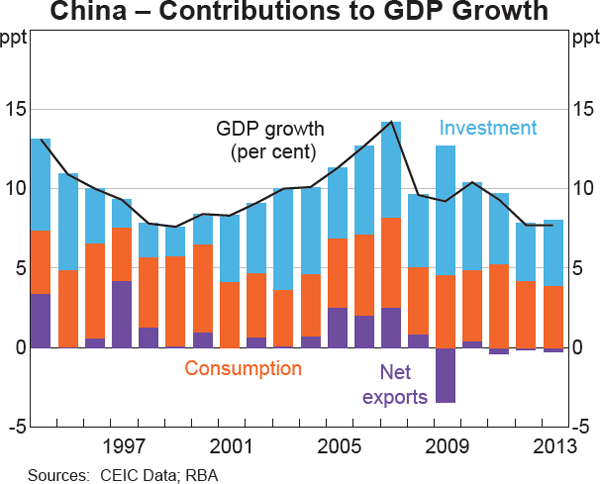
The outlook for Chinese investment in infrastructure also affects significantly the outlook for Australian exports. Infrastructure investment is intensive in the use of steel, which in turn relies on coking coal and iron ore inputs. Together these two commodities accounted for a third of Australia's exports in 2013. Hence, further infrastructure development in China should help to support Australian exports in coming years.
Trends in Infrastructure Investment
Infrastructure can be classified in various ways, but a standard grouping is:
- municipal infrastructure, such as street lighting, urban roads, bridges and subterranean infrastructure
- utilities, such as gas, water and electricity
- transportation, such as highways and rail
- social infrastructure, such as schools and hospitals.
The Chinese National Bureau of Statistics provides a breakdown of infrastructure investment by type through data on fixed asset investment (FAI).[1] It is important to note, however, that FAI overstates investment growth as measured in the national accounts (which unfortunately does not provide a breakdown by industry). This is because FAI data include second-hand asset sales and land sales. Since 2004, investment in infrastructure has accounted for between 25 and 35 per cent of total FAI in China, and has grown in nominal terms by an average annual rate of 20 per cent (Graph 2).
Municipal infrastructure can be thought of as urban infrastructure – and includes water conservation, waste management and urban road maintenance. Over the past decade, this has comprised the largest share of infrastructure investment, accounting for almost 30 per cent of the total (Graph 3). The rapid growth of municipal investment is not surprising given China's ongoing urbanisation process. Over this period, almost 190 million people have migrated from rural areas to cities.[2] As well as building more cities, China has expanded the coverage and quality of municipal infrastructure within cities. For example, 65 per cent of China's population now have access to reliable sanitation facilities, compared with just under 24 per cent in 1990 (World Bank 2014).[3]
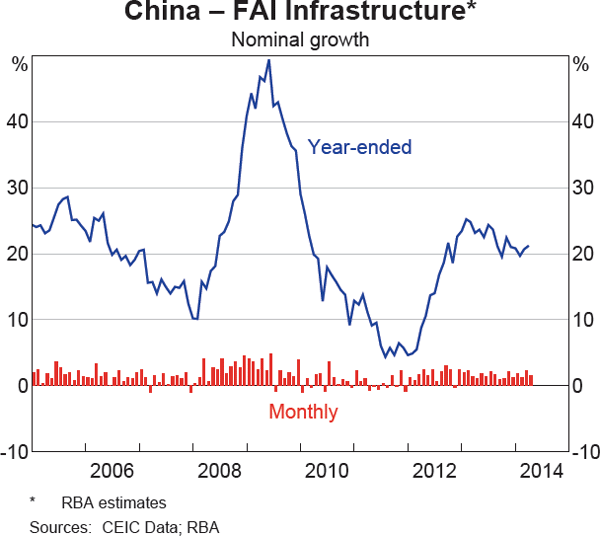
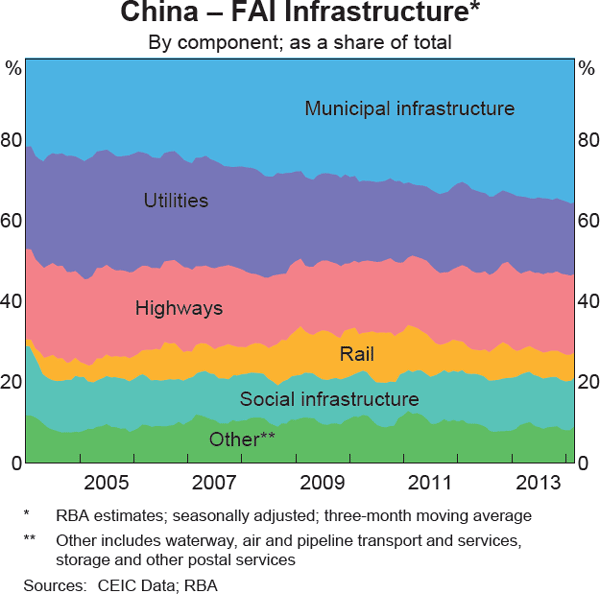
Utilities have been the second largest component of infrastructure investment over the past decade, comprising around one-quarter of infrastructure investment. This share has been on a declining trend, as the majority of households have attained access to reliable utilities over time and the need for further investment has been reduced. Utilities infrastructure increases households' living standards through better and more reliable access to clean water and power. This infrastructure is also a vital input to industrial production, which requires a reliable energy supply. During the past decade, electricity infrastructure has accounted for almost two-thirds of utilities investment; this investment has resulted in more than 99 per cent of the population now having access to electricity (World Bank 2014). Access to reliable water sources has also reached 98 per cent of the population in urban areas. The share of investment in water production and supply has continued to grow steadily, probably as a reflection of deficiencies in rural water access (with only 85 per cent of the rural population having access to basic safe water facilities).
Transportation infrastructure has comprised roughly a quarter of total infrastructure investment. Investment in roads has been the largest component of this expenditure, accounting for around 20 per cent of overall infrastructure investment. This investment has seen China's highways expand from 1 million kilometres in 1990 to 4.3 million kilometres in 2013. Investment in rail networks occupies a smaller portion of China's investment in infrastructure and tends to be more volatile than that of many other major infrastructure sectors. Nevertheless, rail investment has resulted in a 77 per cent increase in the length of track since 1990, and an even larger increase in passenger travel in the past 10 years (see ‘Box A: Railway Infrastructure in China’).
Social infrastructure has accounted for about 12 per cent of infrastructure investment over the past decade. This category includes cultural infrastructure as well as health care and education facilities. Since 2004, investment in education infrastructure (such as schools, universities and vocational training facilities) has declined from about 70 per cent to 40 per cent of social infrastructure investment (although the level of investment in education infrastructure has continued to grow). An increased share of spending has been directed towards cultural infrastructure (which includes libraries, museums and sporting facilities). Overall, the share of investment directed towards health care and other social infrastructure has steadily increased since 2004.
In addition to being employed to advance the longer-term development of the Chinese economy, infrastructure investment has also been used as a countercyclical policy tool to stimulate economic activity. This was most evident during 2008–09, when the government rapidly implemented a stimulus program targeted at infrastructure in response to the global financial crisis.[4] Reflecting the government's stimulus measures, year-ended growth in nominal infrastructure investment (as measured by FAI data) peaked in 2009 at almost 50 per cent. While the increase in investment was broad based across all components of infrastructure, rail investment increased at a particularly rapid pace and was an example of how the construction of long-term infrastructure projects in China have been quickly mobilised to provide a short-term stimulus. The stimulus was gradually unwound over 2010 and 2011 as economic conditions in the rest of the world improved.
Although it is common for governments to be involved in the provision of infrastructure, the level of government involvement in China is high by world standards. Chinese government investment accounted for approximately 85 per cent of all infrastructure investment in 2012, compared with less than half in Australia and between 50 and 60 per cent for a large emerging economy like Brazil. Infrastructure planning and development in China is carried out by multiple government institutions. The State Council and the National Development and Reform Commission (NDRC) are both responsible for the direction of infrastructure investment.[5] The NDRC is responsible for the approval of large infrastructure projects, with the approval of smaller projects the responsibility of provincial development and reform commissions. However, the role of the NDRC could change in coming years. Recent reforms announced by the State Council and NDRC aim to decentralise the project approval process and facilitate a greater contribution to infrastructure from private investment, as well as increase the transparency and efficiency of the approval system (NDRC 2013).[6]
Outlook for Infrastructure
Investment
Although the improvement in the scale and quality of infrastructure over the past two decades is evident across a variety of social and economic indicators, there is still some way to go before China achieves convergence with the provision of infrastructure seen in advanced economies, including Asian economies that are further along the path of economic development. For example, the share of paved roads in China remains well below that seen in Japan and South Korea, as does the level of access to reliable sanitation and water facilities (Table 1). And even though China is more economically developed than India, it has a similar share of paved roads and slightly less access to standard water facilities.
In addition to converging with the standards of developed economies, the ongoing process of rural-urban migration in China will add to the demand for improvements in national infrastructure. The government's recent urbanisation plan targets an increase in the urbanisation rate to 60 per cent by 2020, a 6 percentage point increase from the current level (Graph 4). This implies an additional 100 million people migrating from agricultural and rural areas to the cities, and an estimated CNY 42 trillion of investment (74 per cent of one year's worth of GDP) spread over the next six years (Wang B 2014). When compared with other developing economies like Brazil and Argentina, it is evident that China still has a large potential to urbanise further.
| China | US | Japan | South Korea | India | |
|---|---|---|---|---|---|
| Gross national income per capita(a) | 5,720 | 52,340 | 47,880 | 22,670 | 1,580 |
| Paved roads (per cent of total)(b) | 54 | 98 | 78 | 79 | 50 |
| Reliable access to water(c) | 85 | 94 | 100 | 88 | 90 |
| Reliable access to sanitation | 65 | 100 | 100 | 100 | 35 |
|
(a) 2012, current US dollars Sources: RBA; World Bank |
|||||
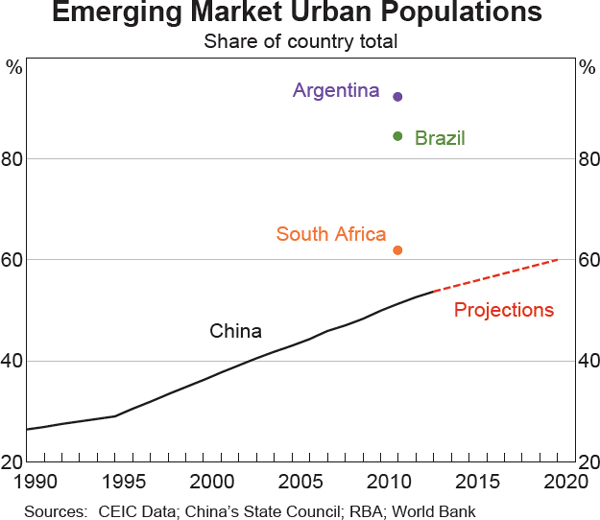
For a larger urban population to be accommodated, substantial investment in municipal infrastructure and transport infrastructure will be required. The government has emphasised the need for greater investment in municipal infrastructure, particularly subterranean infrastructure (pipes, sewage works, flood management systems, etc) (State Council 2013, 2014a). Significant improvements are also expected to be made to urban roads, bridges, pedestrian and bicycle paths, and to urban ecological developments. Specifically, China is aiming to improve sewage treatment and garbage disposal rates in urban areas by around 10 percentage points, to cover 95 per cent of the urban population by 2020 (State Council 2014a).
Investment in the social sector (e.g. aged care) is likely to receive increasing attention from policymakers. China is currently facing demographic challenges as a result of its population control policies and the nature of its economic development process. While the care of parents and elderly relatives has traditionally fallen to their children, China's one-child policy and growing geographic dispersion of families (due in part to the migration of young people to urban centres) mean that the task of aged care is becoming increasingly difficult to manage. To respond to these challenges, Chinese authorities are working to ensure that 98 per cent of the urban population has medical insurance and more than 90 per cent are covered by the old age pension by 2020, compared with 95 per cent and 67 per cent currently (State Council 2014a). While, on some metrics, China's medical infrastructure compares favourably to some developed economies, it remains low compared with some developed east Asian and emerging economies (Graph 5). However, the quality of healthcare provision obviously depends on several other factors besides just infrastructure, and China significantly lags most developed countries on these terms, such as the number of doctors per person and the quality of health services. Aged care homes and medical facilities are likely to require further investment to accommodate urbanisation and an ageing population.
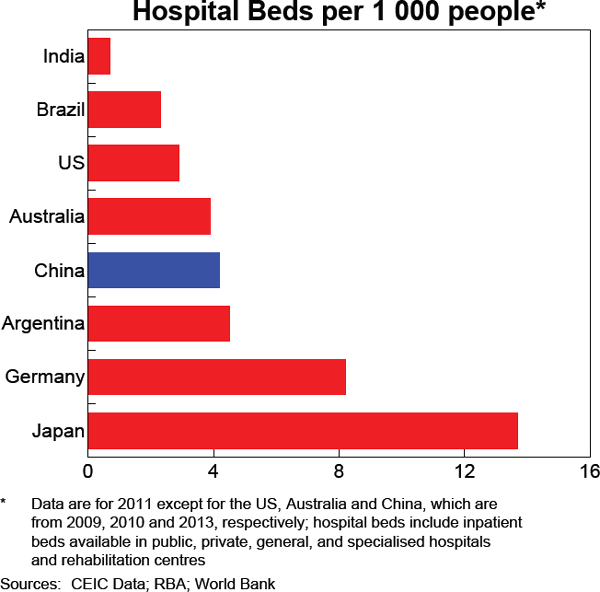
Box A: Railway Infrastructure in China
Railway infrastructure is important for the Chinese economy because China's vast geographic size, difficult terrain and weather conditions make rail one of the most reliable forms of transport. Passenger and freight rail transport is also one of the most steel-intensive forms of infrastructure investment.[1] Railway track is routinely subjected to high levels of physical stress (particularly high-speed rail lines) and therefore requires high-quality steel as inputs. Railway infrastructure in China largely comprises national rail lines and urban subway systems.
China's ongoing need for the development of rail infrastructure is apparent in demographic, track length and usage metrics. OECD data illustrate that city rail transport in China is underdeveloped relative to that of large cities of similar sizes in other countries. A comparison of Beijing's rail infrastructure (which is well developed by Chinese standards) with that of London or Tokyo highlights the scope for expansion. For example, Beijing's population of approximately 18 million is serviced by 458 kilometres of rail lines, representing 26 kilometres of rail per million people, compared with 192 kilometres per million in London and 69 kilometres per million in Tokyo (Table A1).
Outside of urban centres in China, plans are underway to build a more connected rail network. These plans, detailed in China's 12th Five Year Plan and recently re-emphasised (State Council 2014b), entail extending rail lines to reach China's lesser developed central and western regions and connecting ‘satellite cities’. The underdeveloped western and central regions are where most of China's planned 120,000 kilometres of operational rail lines are set to be constructed by 2015, implying a substantial pick-up in construction if this target is to be met (Graph A1) (NPC & CPPCC 2011). This also includes ongoing efforts to extend high speed rail to cover all cities with a minimum population of 500,000 by 2020. China's plans to extend subway lines in urban centres could see over 6,000 kilometres of additional rail networks constructed within just 35 cities by 2030 (OECD 2013).
| Length of system Kilometres | Demographic indicators | Availability
Km per million people |
||
|---|---|---|---|---|
| Population (millions) |
Density (people/km2) |
|||
| International cities | ||||
| London | 2,348 | 12 | 2,951 | 192 |
| Tokyo/Yokohama | 2,139 | 31 | 5,934 | 69 |
| New York | 1,435 | 20 | 1,823 | 71 |
| Seoul/Incheon | 950 | 23 | 10,402 | 42 |
| Large Chinese cities | ||||
| Beijing | 458 | 18 | 4,808 | 26 |
| Shanghai | 368 | 22 | 5,776 | 17 |
| Guangzhou | 232 | 10 | 5,263 | 22 |
| Shenzhen | 178 | 10 | 6,579 | 19 |
| Chongqing (City) | 87 | 8 | 7,979 | 12 |
|
(a) As of 2012; population is of state/municipality administrative area Source: OECD |
||||
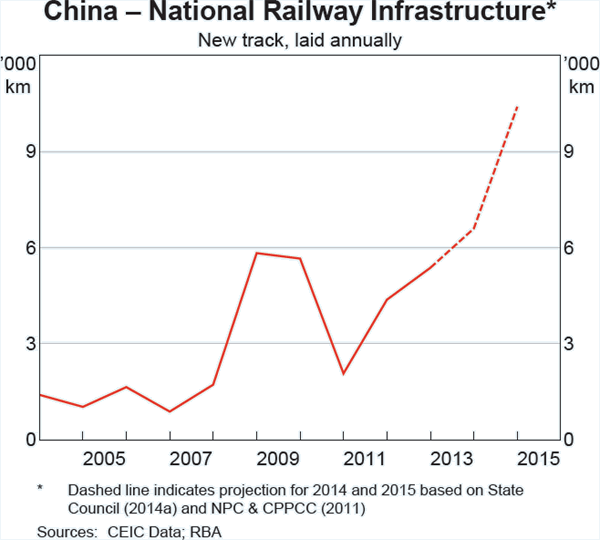
Risks to the Infrastructure Investment Outlook
Although the outlook for infrastructure investment in China generally appears strong, there are nevertheless some significant risks. These risks mainly relate to the dominant role of the government in allocating and financing infrastructure investment. Around 85 per cent of infrastructure investment in China is undertaken by the state – a much higher percentage than is typical in other countries. In the absence of a strong framework of project prioritisation and transparent cost-benefit analysis, the reliance on government-directed investment creates the potential for misallocation of resources through inefficient investment. Despite making progress towards broader economic reform, the lack of market price mechanisms in many types of infrastructure industries increases the risk of poor investment decisions. Over-investment also contributes to the crowding out of private investment at a time when contributions from the private sector are being encouraged.
A related risk involves the current method of financing infrastructure investment in China. Typically, large nationwide infrastructure projects in China are financed by the central government, while the financing responsibilities of smaller projects fall to local governments. This is similar to most economies, but the configuration of China's fiscal arrangements means that local governments do not always have the capacity to finance investment out of revenues or by issuing debt. As a result, alternative sources of financing have been used, such as specially designed local government financing vehicles (LGFVs). According to the 2013 Audit of Chinese central and local government debt, 39 per cent of local government debt was sourced from LGFVs. These LGFVs have come under scrutiny recently as the sources of their funds are not always clear and may originate through non-bank financing channels. This has led to concerns about the sustainability of China's increasingly large local government debt, particularly as infrastructure may not generate sufficient financial returns over the period in which funds are borrowed to service this debt.
Chinese authorities have proposed reforms to address these risks. The government has proposed the use of municipal bonds in order to broaden the sources of funding for local governments and to increase transparency.[7] In addition, Chinese authorities have highlighted the need to reform revenue collection and sharing arrangements between the central and local governments (Ministry of Finance 2014).
More broadly, Chinese reform proposals have highlighted the need for private sector involvement in infrastructure investment and to allow market forces to play a more important role in allocating resources. Proposed reforms include supportive measures for public-private partnerships (PPPs) in order to attract more private capital for infrastructure investment. Alongside these reforms and following pilot programs launched in Harbin and Luoyang, the State Council recently announced plans to launch 80 PPPs in infrastructure industries (State Council 2014c), including a new subway line in Beijing and several new ports.[8] Efforts to simplify and decentralise the investment approval process should help to attract more PPPs. But, as experience in many other countries has shown, there are a lot of preconditions required in order for these partnerships to be successful, and PPPs tend to make up only a small share of infrastructure financing even in advanced economies. In addition to broader institutional settings that mitigate private investors' concerns over political risk, PPPs require particularly careful risk assessment and appropriate risk sharing. To this end, China has invited the World Bank to collaborate on PPP projects and related social capital planning (State Council 2014d).
The challenges of financing infrastructure investment are not unique to China. The sustainable financing of infrastructure investment has been on the agenda of the G20 for the past two years. The G20 has reaffirmed the critical importance that these investments play in supporting economic growth and is discussing ways to facilitate the efficient allocation of global savings to long-term infrastructure financing. Actions that can improve project preparation, planning and funding are a key priority, along with broader improvements to institutional settings in G20 countries (Chong and Poole 2013).
Conclusion
Infrastructure investment in China has proceeded rapidly over the past few decades, contributing significantly to economic growth and improved standards of living. The expansion and upgrading of China's infrastructure has had a significant impact on the Australian economy as iron ore and coking coal are key inputs into the production of steel, which is in turn used intensively in infrastructure-related construction. If the Chinese economy continues to converge – on a range of development indicators – with advanced economies and the share of the population dwelling in urban areas grows further over time, Chinese investment in infrastructure should continue to support the global demand for raw materials. While infrastructure investment on the scale being undertaken in China today is not without its risks, these may be mitigated to some extent by reforms proposed by authorities, including those that target greater private sector participation in the allocation, execution and financing of this investment.
Footnotes
The authors completed this work in Economic Group. [*]
FAI data are compiled via a sample of investment projects larger than CNY 5 million. For more details, see Roberts and Rush (2010). [1]
The number of cities and towns (defined as areas with populations of at least 2,500, of which at least 70 per cent are non-agricultural population) in China has also increased substantially over a longer period of time, numbering just over 2,000 in 1978 and rising to around 20,000 in 2010 (State Council 2014a). [2]
Reliable facilities refer to standard facilities, as defined by the World Bank, such as flush/pour flush (to piped sewer system, septic tank, pit latrine), ventilated improved pit latrine, pit latrine with slab and composting toilet. [3]
For more details on China's stimulus during the global financial crisis, see McKissack and Xu (2011) and Sadeghian, White and D'Arcy (2013). [4]
The State Council, sometimes referred to as China's cabinet, is China's chief administrative and planning body on economic, political and social matters. [5]
The NDRC is expected to undertake a transition from an emphasis on micro-level control of projects to a broader regulatory and institutional design focus (Zheng 2014). [6]
Currently, local governments are prohibited from borrowing or issuing bonds directly, with the central government issuing bonds on behalf of local governments to finance their budget deficits. A new trial program has been launched to allow 10 local governments to issue municipal bonds in 2014 (Shanghai, Zhejiang, Guangdong, Shenzhen, Jiangsu, Shandong, Beijing, Jiangxi, Ningxia and Qingdao). Local governments will receive no support from the central government or Ministry of Commerce and Finance for the principal or interest of these bonds (as was previously the case). See Wang W (2014) for more information. [7]
For more information on the PPPs, including a list of the approved projects, see NDRC (2014) and accompanying attachment. [8]
Footnote Box A
A case study of a high-speed rail project in France (World Steel Association 2010) found that each kilometre of rail required 215 tonnes of steel, with steel-reinforced concrete, steel rail and steel structures accounting for 43 per cent, 36 per cent and 21 per cent, respectively. [1]
References
Chong S and E Poole (2013), ‘Financing Infrastructure: A Spectrum of Country Approaches’, RBA Bulletin, September, pp 65–76.
McKissack A and J Xu (2011), ‘Chinese Macroeconomic Management through the Crisis and Beyond’, Australian Treasury Working Paper 2011-01.
Ministry of Finance (2014), ‘关于2013年中央和地方预算执行情况与2014年中央和地方预算草案的报告 [Report on the Implementation of the 2013 Central and Local Government Budgets and 2014 Draft Budgets]’, 5 March. Available at <http://www.mof.gov.cn/zhuantihuigu/2014ysbg/ysbg2014/201403/t20140315_1055691.html>.
NDRC (National Development and Reform Commission) (2013), ‘ 关于改进规范投资项目核准行为加强协同监管的通知 [Notice on Improving the Approval Process and Coordination of Investment Projects]’, Media Release No 2662, 28 December. Available at <http://www.sdpc.gov.cn/zcfb/zcfbtz/201401/t20140103_574375.html>.
NDRC (2014), ‘ 国家发展改革委关于发布首批基础设施等领域鼓励社会投资项目的通知 [First Round of Socially Financed Infrastructure Projects Issued by the NDRC]’, Media Release No 981, 18 May. Available at <http://www.ndrc.gov.cn/gzdt/201405/t20140521_612323.html>.
NPC & CPPCC (2011), ‘12th Five Year Plan 2011–2015’, Translated by the British Chamber of Commerce. Available at <http://www.britishchamber.cn/content/chinas-twelfth-five-year-plan-2011-2015-full-english-version>.
OECD (Organisation for Economic Co-operation and Development) (2013), ‘Economic Survey of China’, Survey, March. Available at <http://www.oecd.org/china/economic-survey-china.htm>.
Roberts I and A Rush (2010), ‘Sources of Chinese Demand for Resource Commodities’, RBA Research Discussion Paper No 2010-08.
Sadeghian D, G White and P D'Arcy (2013), ‘Macroeconomic Management in China’, RBA Bulletin, June, pp 11–20.
State Council (2013), ‘ 国务院关于加强城市基础设施建设的意见 [State Council Notice on Strengthening Urban Infrastructure]’, Media Release No 36, 16 September. Available at <http://www.gov.cn/zwgk/2013-09/16/content_2489070.htm>.
State Council (2014a), ‘ 国家新型城镇化规划 (2014–2020 年) [National ‘New Type’ Urbanisation Plan 2014–2020]’, 16 March. Available at <http://www.gov.cn/xinwen/2014-03/16/content_2639841.htm>.
State Council (2014b), ‘ 李克强主持召开国务院常务会议 [State Council Meeting Chaired by Li Keqiang] (on Railway Investment, Business Taxes and Social Housing)’, 2 April. Available at <http://www.gov.cn/guowuyuan/2014-04/02/content_2652125.htm>.
State Council (2014c), ‘ 李克强主持召开国务院常务会议 [State Council Meeting Chaired by Li Keqiang] (on the Implementation of PPPs)’, 23 April. Available at <http://www.gov.cn/guowuyuan/2014-04/23/content_2665259.htm>.
State Council (2014d), ‘ 国务院推80个PPP项目铁路港口均在列 [State Council Announcement to Promote 80 Rail and Port PPPs]’, 24 April. Available at <http://www.gov.cn/xinwen/2014-04/24/content_2665567.htm>.
Wang B (2014), ‘ 王保安副部长在政府和社会资本合作 (PPP) 培训班上的讲话 [Speech by Vice Foreign Minister Wang Bao'an on Government and Social Capital Cooperation]’, 政府和社会资本合作 (PPP) 培训班 [Government and Social Capital Cooperation Seminar], 17 March. Available at <http://www.mof.gov.cn/zhengwuxinxi/caizhengxinwen/201403/t20140319_1057275.html>.
Wang W (2014), ‘China Allows 10 Provinces and Cities to Sell Bonds on Own Credit’, The Wall Street Journal, 21 May, online. Available at <http://online.wsj.com/article/BTCO-20140520-715873.html>.
World Bank (2014), ‘Global Development Indicators’, Data accessed on 25 April. Data available at <http://data.worldbank.org/indicator>.
World Steel Association (2010), ‘Environmental Case Study: High-Speed Rail’, April. Available at <http://www.worldsteel.org/dms/internetDocumentList/case-studies/Rail-case-study/document/Rail%20case%20study.pdf>.
Zheng Y (2014), ‘NDRC Plans Internal Reforms’, China Daily, 6 March. Available at <http://www.chinadaily.com.cn/china/2014npcandcppcc/2014-03/06/content_17325570.htm>.